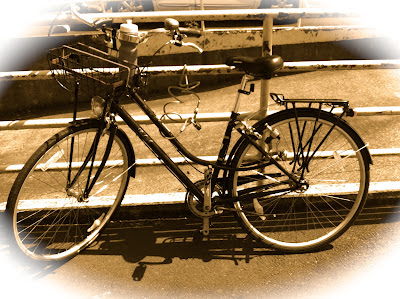I suspect one of the chief
obstacles (in both the literal and metaphorical sense) to many people biking is
hill-climbing. Biking can be challenging enough for new utility cyclists, what
with rules of the road, gears, braking, dealing with traffic, the weather,
&c. Add to this some steep-ish hills that heat a person up and make special
cycling clothes seem unavoidable, and it all gets to be too much for many
people to “make the leap” into regular utility biking. I do have a suggestion,
though:
Get off and walk your bike up the hill.
Unless you live in a very
hilly location, walking a bike uphill is legal, sane, and perfectly reasonable.
To me, the interesting question is: why is walking a bike up hill so difficult
for us today? It wasn’t always this way.
I can remember seeing lots of
people (except young men out to prove something to themselves or others)
walking their bikes up hill when I was young. Then came ten speeds. Suddenly,
cycling was only about sport, fitness,
and intensity. To dismount from your bike and walk up the hill was a sign of
being a sissy, a wimp, a fatso. So, people had to strain, sweat, and nearly
kill themselves to stay in the saddle at all costs so as not to imply they were
abject physical failures. This all
happened about the same time as it became rare to see middle-aged and older
people on bikes around town. These two things seem related to me.
Utility cycling is a great
way to get out of the “rat race” by opting for transport that is slower and
healthier for the total person. It should not (in my opinion) be about
substituting one obsessive compulsion for another. Using a bicycle needn’t
always involve getting covered in sweat. It can be a fairly mellow activity.
Sure, exercising via bicycle is great, but is that the only way we can justify
things in our society? Must it always involve some tangible “product” or
“benefit?”
Just a few days ago, I was
walking up a hill when I met up with a neighbor walking his dog. It turned out
that we were both going the same way, and the block or two we walked together
proved both interesting and enjoyable. Yes, I missed a little cardio exercise,
true; but a connection was made that I would have missed had I treated cycling
as yet more hyper-focused American foolishness. So many of us say we want to
live a more European-paced life: perhaps we ought to start doing so in the myriad little ways we are able. I’m
beginning to see more seniors out on well-made, multi-weather upright bikes
going at a reasonable pace these days, and I think it is a sign that sanity is
returning in the cycling world. Let’s add walking bikes uphill to the Utility
Cycling Manifesto (if such a thing exists)!
Cycling where I live involves
some moderate hills. I’ve become able to go up most of them in the saddle
fairly comfortably…but there are a couple of routes that have me walking up the
hill, especially in warm weather. When I do so, someone driving or pedaling by
is probably thinking “poor fellow—he
can’t even make it up that hill.” But I could be thinking at that same
moment “poor soul—s/he is more concerned
with speed than living.”
Perhaps we all ought to be
thinking less about the judgments and more about how we can lead healthy,
balanced lives.






